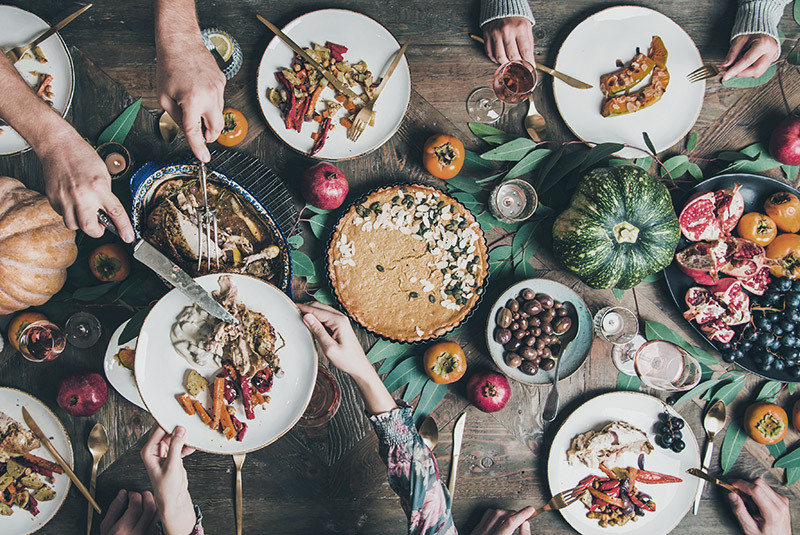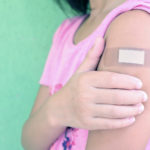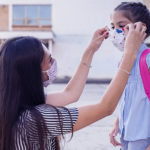Pass the pie and a mask: COVID-19 safety tips for the holidays

This holiday season will seem different than the last one — but it’s still not the season to blissfully ignore health and safety measures that combat COVID-19.
Thanks to the availability of COVID-19 vaccines, families shouldn’t feel obligated to repeat last year’s unprecedented public health guidance to hunker down at home for the holidays. This year, you can drive over the hills and through the woods to visit grandmother, other relatives, and friends.
“We are in a better place,” says Dr. Kristin Moffitt, a pediatric infectious disease specialist at Boston Children’s Hospital. “Last holiday season, we only had interventions such as masking and distancing to reduce the transmission of COVID-19 that led to severe illness and death.”
Still, rising case counts are a stark reminder that you and your family should celebrate the holidays with caution, especially if grandma and young children are involved. Even though the introduction of vaccines early this year reduced the chance of becoming seriously ill, not everyone is vaccinated, Dr. Moffitt says. Even then, vaccination reduces the likelihood of becoming infected, but not completely. If you want to keep your family safe as you travel or open the door to your home, consider following these COVID-19 safety tips for the holidays:
Plan around COVID-19 cases, vaccination rates, and Omicron
The holidays arrive as the U.S. sees an increase in COVID-19 cases and as the world waits for more certainty around the emerging Omicron variant. Vaccine manufacturers are testing the effectiveness of their vaccines against the new strain, while health experts are determining whether Omicron spreads more easily than previous variants have. They expect to have answers by mid-December.
As of November 17, the most recent date of available data, the Centers for Disease Control and Prevention (CDC) reported that the seven-day average of daily new COVID-19 cases (88,482) had increased 16 percent, compared with the previous average of 76,223.
Another important measurement is the number of people vaccinated. According to CDC vaccination data updated on November 30, 70 percent of eligible U.S. residents have at least one dose of a COVID-19 vaccine, while 59 percent are fully vaccinated. Twenty percent of those who are fully vaccinated have received a booster dose. Health officials have long thought that at least 80 percent of the population should be vaccinated to reach herd immunity.
Young children can get vaccinated
In what many parents consider to be an early holiday gift, children ages 5 to 11 were given the green light last month to receive the Pfizer-BioNTech vaccine. It’s important for children in this age group to start the series of two vaccines as soon as possible, Dr. Moffitt says. “They would have had to have started the series on November 19 to be fully immunized by Christmas. But even having one dose by late December is a big step towards immunity.”
Protect the vulnerable at gatherings
If you host or join a gathering of extended family and friends, Dr. Moffitt recommends several steps to protect the health of children under five and older individuals who are immunized but still have a risk of becoming seriously ill from COVID-19. Open doors and windows as much as possible, wear masks when not eating, go outside for physical activities, or sit around an outdoor fire. “Get creative and still enjoy the company of others,” she says.
Hunker down after the holidays
In case you and your children were exposed to COVID-19 at a gathering, you might want to be extra vigilant for at least a week afterwards, Dr. Moffitt says. If possible, work from home. You and your children can also wear a mask in public spaces even if you are fully vaccinated. Many children are tested for COVID-19 at school, so your child’s results after the holiday break might allay any concerns you have about their health.
Have tough conversations before celebrating
“Every family has to do a risk-benefit calculation,” Dr. Moffitt says. Have conversations with family and friends to determine their level of vaccination. If the numbers aren’t to your liking, consider celebrating next year if it’s too much stress this year. If you feel comfortable traveling somewhere or hosting at your home, don’t put it off. Humans have a need to bond, she says.
“It’s important to get together with family and friends, but doing it as safely as possible is something we need to be thoughtful about.”
Get more answers for your family about COVID-19.
Related Posts :
-

COVID vaccines are here for kids ages 5 to 11. Here’s what families should know.
On November 2, 2021, the U.S. Centers for Disease Control and Prevention (CDC) signed off on the use of the Pfizer-BioNTech ...
-

Improving treatment process so kids can return to sports after COVID-19
Children can’t wait for the next game, the next tournament. Sports means many things to them, including an escape ...
-

The great mask debate: how to deal with bullying over face masks in school
As the war against COVID-19 rages on, so do the battles about the best ways to stop the spread. And, ...
-

What makes the Delta variant of COVID-19 so contagious?
The Delta variant of SARS-CoV-2 has swept the planet, becoming the dominant variant within just a few months. A new ...





